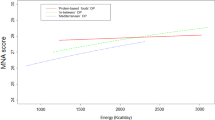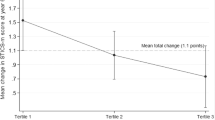Abstract
Objective:
To examine the factors related to the decline of dietary variety among the rural community-dwelling Japanese elderly people and the implication on the planning of elderly people's nutritional improvement program in the future.
Design:
A prospective cohort study during 8-year follow-up from 1992 to 2000.
Setting:
This study was conducted in Nangai Village, a rural and mainly agricultural area of Akita Prefecture in the northern part of Honshu, one of four main islands in Japan.
Subjects:
A total of 417 elderly people (160 men, 257 women) who completed interviews and food intake frequency surveys conducted in 1992, 1994, 1996, 1998, and 2000 were studied.
Methods:
Dietary variety and variables potentially associated with dietary variety decline were identified from a face-to-face interview at the baseline and 8-year follow-up surveys. The dietary variety was measured using the dietary variety score (DVS), which covers the 10 main food groups in Japanese meals.
Results:
During the 8-year follow-up, 36.2% of the subjects showed a decline in dietary variety. Health characteristics also change among the 8-year follow-up and these changes have an effect on the decline of dietary variety. Significant predictors for decline in dietary variety included loss of spouse, deterioration in self-perceived chewing ability, and decrease in intellectual activity score.
Conclusions:
Loss of spouse, deterioration in chewing ability, and decline in intellectual activity may increase the risk of decline in dietary variety in community-dwelling Japanese elderly people.
This is a preview of subscription content, access via your institution
Access options
Subscribe to this journal
Receive 12 print issues and online access
$259.00 per year
only $21.58 per issue
Buy this article
- Purchase on Springer Link
- Instant access to full article PDF
Prices may be subject to local taxes which are calculated during checkout
Similar content being viewed by others
References
Allen F, McMillan A (2002). Food selection and perceptions of chewing ability following provision of implant and conventional prostheses in complete denture wearers. Clin Oral Implants Res 13, 320–326.
Bakke M, Holm B, Gotfredsen K (2002). Masticatory function and patient satisfaction with implant-supported mandibular overdentures: a prospective 5-year study. Int J Prosthodont 15, 575–581.
Bartali B, Salvini S, Turrini A, Lauretani F, Russo CR, Corsi AM et al. (2003). Age and disability affect dietary intake. J Nutr 133, 2868–2873.
Bergendal T, Magnusson T (2000). Changes in signs and symptoms of temporomandibular disorders following treatment with implant-supported fixed prostheses: a prospective 3-year follow up. Int J Prosthodont 13, 392–398.
Bernstein MA, Tucker KR, Ryan ND, O’neill EF, Clements KM, Nelson ME et al. (2002). Higher dietary variety is associated with better nutritional status in frail elderly people. J Am Diet Assoc 102, 1096–1104.
Drewnowki A, Ahlstrom S, Driscoll A, Rolls BJ (1997). The dietary variety score: assessing dietary quality in healthy young and older adults. J Am Diet Assoc 97, 266–271.
Drewnowki A, Shultz JM (2001). Impact of aging on eating behaviors, food choices, nutrition and health status. J Nutr Health Aging 5, 75–79.
Erlangsen A, Jeune B, Bille-Brahe U, Vaupel JW (2004). Loss of partner and suicide risks among oldest old: a population-based register study. Age Ageing 33, 378–383.
Fujiwara Y, Shinkai S, Kumagai S, Amano H, Yoshida Y, Yoshida H et al. (2003). Longitudinal changes in higher-level functional capacity of an older population living in a Japanese urban community. Arch Gerontol Geriatr 36, 141–153.
Fung TT, Rimm EB, Spiegelman D, Rifai N, Tofler GH (2001). Association between dietary patterns and plasma biomarkers of obesity and cardiovascular disease risk. Am J Clin Nutr 73, 61–67.
Gordon SR, Kelley SL, Sybyl JR, Mill M, Kramer A, Jahnigen DW (1985). Relationship in very elderly veterans of nutritional status, self-perceived chewing ability, dental status, and social isolation. J Am Geriatr Soc 33, 334–339.
Ishizaki T, Watanabe S, Suzuki T, Shibata H, Haga H (2000). Predictors for functional decline among nondisabled older Japanese living in a community during a 3-year follow-up. J Am Geriatr Soc 48, 1424–1429.
Kant AK (1996). Indices of overall diet quality: a review. J Am Diet Assoc 96, 785–791.
Kant AK, Schatzkin A, Harris TB, Ziegler RG, Block G (1993). Dietary diversity and subsequent mortality in the First National Health and Nutrition Examination Survey Epidemiologic Follow-up Study. Am J Clin Nutr 57, 434–440.
Kant AK, Schatzkin A, Ziegler R (1995). Diet diversity and subsequent cause-specific mortality. J Am Coll Nutr 14, 233–238.
Koyano W, Shibata H, Nakazato K, Haga H, Suyama Y (1988). Prevalence of disability in instrumental activities of daily living among elderly Japanese. J Gerontol 43, S41–S45.
Koyano W, Shibata H, Nakazato K, Haga H, Suyama Y, Matsuzaki T (1991). Measurement of competence: reliability and validity of the TMIG index of competence. Arch Gerontol Geriatr 13, 103–116.
Kumagai S, Shibata H, Watanabe S, Suzuki T, Haga H (1999). Effect of food intake pattern on all-cause mortality in the community elderly: a 7-year longitudinal study. J Nutr Health Aging 3, 29–33.
Kumagai S, Watanabe S, Shibata H, Amano H, Fujiwara Y, Shinkai S et al. (2003). Effects of dietary variety on declines in high-level functional capacity in elderly people living in a community. Jpn J Public Health 50, 1117–1124.
Locker D (2002). Changes in chewing ability with ageing: a 7-year study of older adults. J Oral Rehab 29, 1021–1029.
Marshall TA, Stumbo PJ, Warren JJ, Xie XJ (2001). Inadequate nu-trition intakes are common and are associated with low diet variety in rural, community-dwelling elderly. J Nutr 131, 2191–2196.
Marshall TA, Warren JJ, Hand JS, Xie XJ, Stumbo PJ (2002). Oral health, nutrient intake and dietary quality in the very old. J Am Dent Assoc 133, 1369–1379.
Michels KB, Wolk A (2002). A prospective study of variety of healthy foods and mortality in women. Int J Epidemiol 31, 847–854.
Morley JE (2001). Decrease of food intake with aging. J Gerontol Series A 56 (Special Issue II), 81–88.
Osterberg T, Tsuga K, Rothenberg E, Carlsson GE, Steen B (2002). Masticatory ability in 80-year-old subjects and its relation to intake of energy, nutrients and food items. Gerontology 19, 95–101.
Sahyoun NR, Krall E (2003). Low dietary quality among older adults with self-perceived ill-fitting dentures. J Am Diet Assoc 103, 1494–1499.
Seymour JD, Calle EE, Flagg EW, Coates RJ, Ford ES, Thun MJ (2003). Diet quality index as a predictor of short-term mortality in the American cancer society cancer prevention study nutrition cohort. Am J Epidemiol 157, 980–988.
Sheiham A, Steele JG, Marcenes W, Finch S, Walls AW (1999). The impact of oral health on stated ability to eat certain foods findings from the National Diet and Nutrition Survey of Older People in Great Britain. Gerotontology 16, 11–20.
Shibata H, Suzuki T, Shimonaka Y (1997). Overview of a new longitudinal interdisciplinary study on aging (TMIG-LISA, 1991–2000). In: Shibata H, Suzuki T, Shimonaka Y (eds). Facts, Research and Intervention in geriatrics 1997. Longitudinal Interdisciplinary Study on Aging. Serdi Publisher: Paris. pp 7–13.
Suzuki T, Shibata H (2003). An introduction of the Tokyo Metropolitan Institute of Gerontology Longitudinal Interdisciplinary Study on Aging (TMIG-LISA, 1991–2001). Geriatr Gerontol Int 3, s1–s4.
U.S. Department of Health and Human Services (1998). Healthy people 2010 objectives: Draft for public comment. U.S. Government printing office: Washington, DC.
Vellas BJ, Hunt WC, Romero LJ, Koehler KM, Baumgartner RN, Garry PJ (1997). Changes in nutritional status and patterns of morbidity among free-living elderly people: a 10-year longitudinal study. Nutrition 13, 515–519.
Wakimoto P, Block G (2001). Dietary intake, dietary patterns, and changes with age: an epidemiological perspective. J Gerontol A Biol Sci Med Sci 56, 65–80.
Acknowledgements
The present study was a part of a research project, the Tokyo Metropolitan Institute of Gerontology, Longitudinal Interdisciplinary Study on Aging (TMIG-LISA). The authors are grateful to the participants and municipal officers in Nangai Village as well as other staff members of TMIG-LISA for their cooperation with this study.
Author information
Authors and Affiliations
Corresponding author
Additional information
Guarantor: J Kwon.
Contributors: JK was responsible for the design of this study, performed the data analysis and wrote the manuscript. TS, SK, SS and HY contributed to the design and conduct of the TMIG-LISA. TS and SK contributed to the data analysis, interpretation of the data, and writing of the manuscript.
Rights and permissions
About this article
Cite this article
Kwon, J., Suzuki, T., Kumagai, S. et al. Risk factors for dietary variety decline among Japanese elderly in a rural community: a 8-year follow-up study from TMIG-LISA. Eur J Clin Nutr 60, 305–311 (2006). https://doi.org/10.1038/sj.ejcn.1602314
Received:
Revised:
Accepted:
Published:
Issue Date:
DOI: https://doi.org/10.1038/sj.ejcn.1602314
Keywords
This article is cited by
-
Factors associated with weight loss by age among community-dwelling older people
BMC Geriatrics (2023)
-
Association between Oral Frailty and Dietary Variety among Community-Dwelling Older Persons: A Cross-Sectional Study
The journal of nutrition, health & aging (2021)
-
Association between health risks and frailty in relation to the degree of housing damage among elderly survivors of the great East Japan earthquake
BMC Geriatrics (2018)
-
Association between stairs in the home and instrumental activities of daily living among community-dwelling older adults
BMC Geriatrics (2018)
-
Relationship between diet-related indicators and overweight and obesity in older adults in rural Japan
The journal of nutrition, health & aging (2017)



